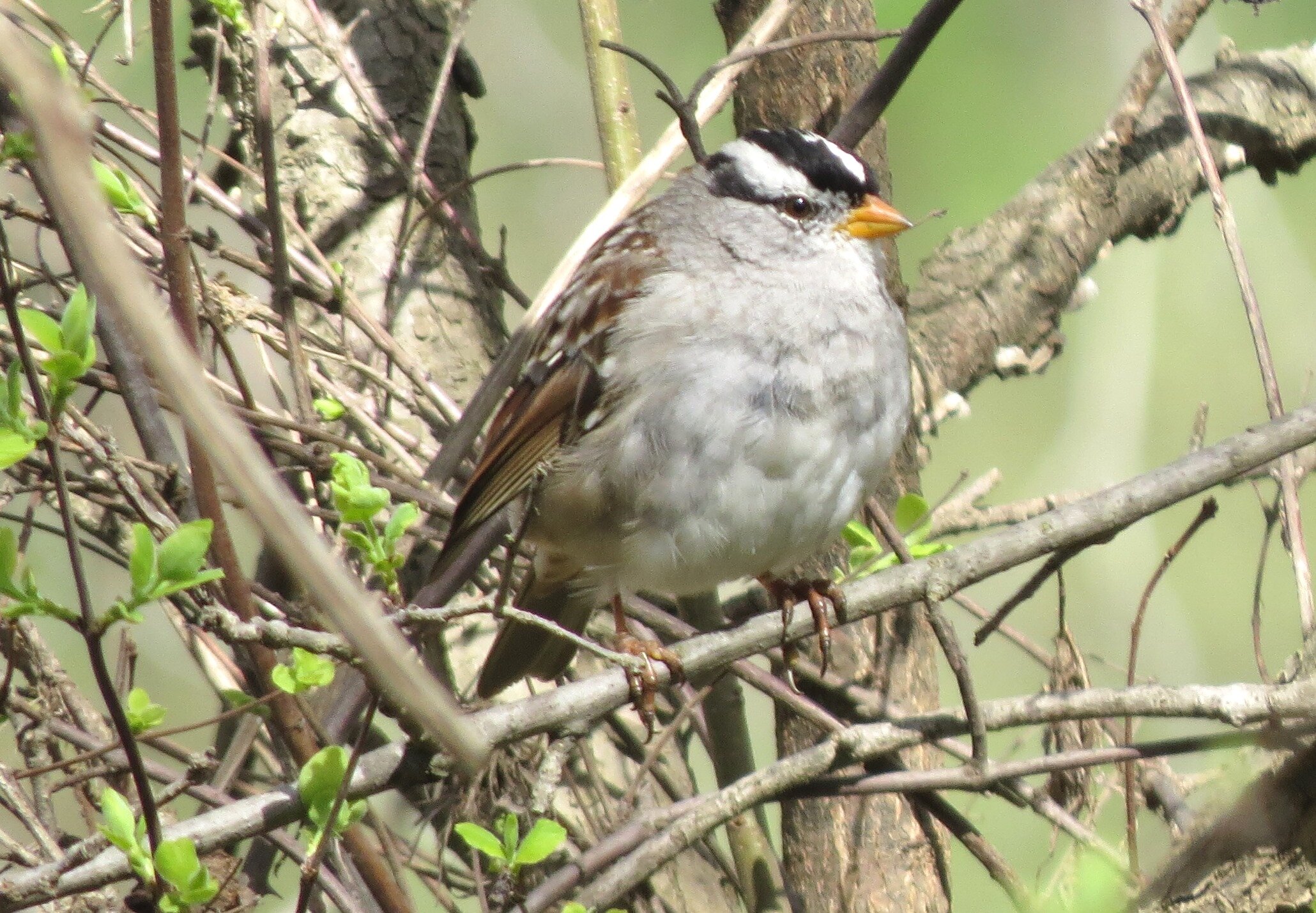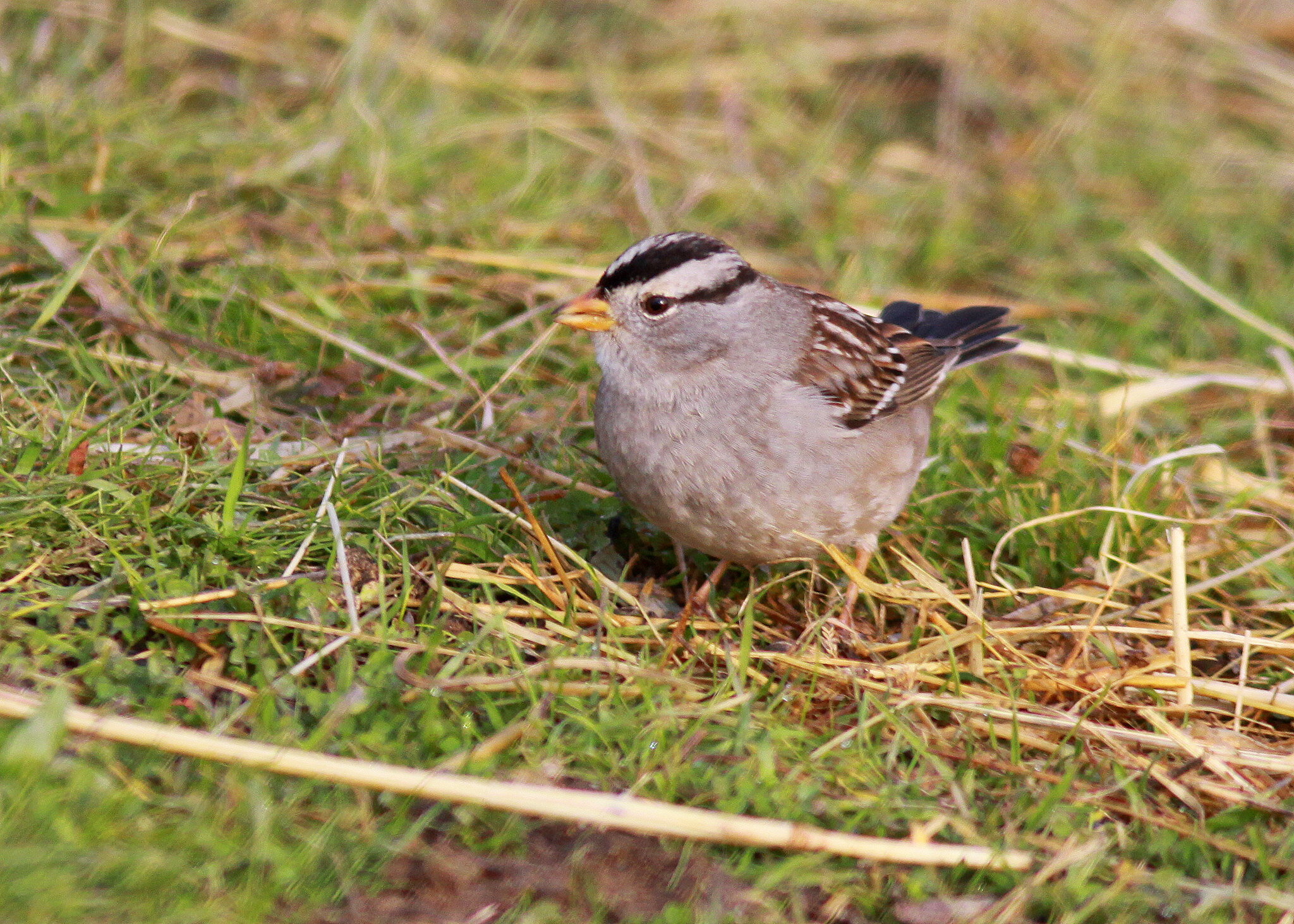Adult White-crowned Sparrow, Image by Chris Conard
This month, let’s learn about a songbird called the White-crowned Sparrow. White-crowned Sparrows migrate into the Sacramento Valley starting in the fall. They stay over winter and leave in the spring to go to their nesting sites. Most populations of White-crowned Sparrows migrate; but there are populations on the Pacific coast and in some areas of the interior West that stay year-round. White-crowned Sparrows are native to North America and are found in the continental U.S., Canada, and northern Mexico. If White-crowned Sparrows are seen in the northeastern U.S., they usually won’t stay long because they are probably just migrating through. One bird that was tracked by scientists during migration flew 300 miles in one night. Alaskan White-crown Sparrows fly 2,600 miles to stay in Southern California for the winter.
What do White-crowned Sparrows look like?
Some species of sparrows may be difficult to identify because they look similar; but White-crowned Sparrows are fairly easy to identify. The adults have “eye-catching” black and white stripes on their heads. The bills of White-crowned Sparrows are small and are either yellow, orange, or pink depending on the subspecies (a group in a species that has slight differences). There are five identified subspecies of the White-crowned Sparrow that live in different regions. White-crowned Sparrows have plain, gray chests and abdomens and have brown wings with light and dark streaking (or lines). They have long tails and their heads can appear either rounded or slightly peaked. Their crown feathers (the feathers on the top of the head) can be raised or lowered at will depending on their mood! Males and females look alike. However, first-year birds, or immatures, have brown and grayish-tan head stripes, instead of the black and white stripes that adults have. Juveniles (the age up until August after hatching) have dark streaks all over their bodies.
Immature White-crowned Sparrow, Image by Nancy J. Kapellas
Where do White-crowned Sparrows live?
One can frequently spot a White-crowned Sparrow either hopping on the ground or perching low inside bushes. They are found in many habitats such as weedy fields, thickets, city parks, suburban yards, alpine meadows, roadsides, agricultural fields, and edges of woodlands. White-crowned Sparrows prefer to have low brush or trees nearby so that they can quickly find shelter when necessary.
It’s the female White-crowned Sparrow that builds the nest. The nests are built with twigs, grasses, pine needles, moss, bark, and dead leaves. Finer grass and sometimes hair is used to line their nests. Nests are usually fairly low to the ground in thickets, not higher than 3-10 feet. In far northern regions where brush or thickets are not available, such as the arctic tundra, White-crowned Sparrows build nests on the ground. These nests are usually hidden behind clumps of moss or in other types of groundcover. The female incubates (or sits on) the eggs to keep them warm. After hatching, both parents help feed their young. When White-crowned sparrow fledglings (young birds that are able to move on their own) leave the nest, they do not learn to fly for another week or so. They remain close to the nest during this time. Siblings may stay together for a few months.
Adult White-crowned Sparrow, Image by Larry Hickey
What do White-crowned Sparrows eat?
White-crowned Sparrows eat many types of food and what they eat can change from season to season. In the winter, they mainly eat seeds; and in the summer, they eat insects, such as caterpillars, wasps, and beetles. In addition, White-crowned Sparrows also eat buds and other plant parts, grains (such as barley, oats, wheat, corn), and berries, such as elderberries and blackberries. In winter, flocks are seen looking for food in open or grassy areas. When searching for food on the ground, White-crowned Sparrows use a successful technique called “double-scratching”. This is when birds turn over leaves when they hop in one direction and then quickly hop in the opposite direction to pounce on food, such as insects or seeds, that are suddenly exposed.
What do White-crowned Sparrows sound like?
White-crowned Sparrows have a beautiful song and also have a few different calls. Each subspecies in their specific regions have slightly unique song versions. It is thought that males sing more often; but that females do sing as well. You can listen to the White-crowned Sparrow now.
These songs and calls of the White-crowned Sparrow are from xeno-canto. More White-crowned Sparrow vocalizations can be found at xeno-canto.org/species/Zonotrichia-leucophrys.







